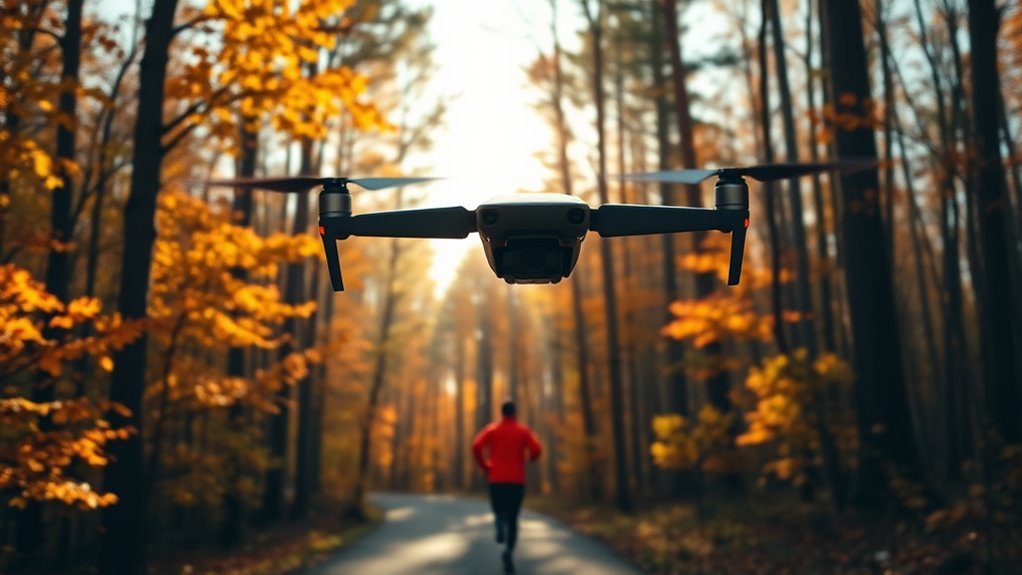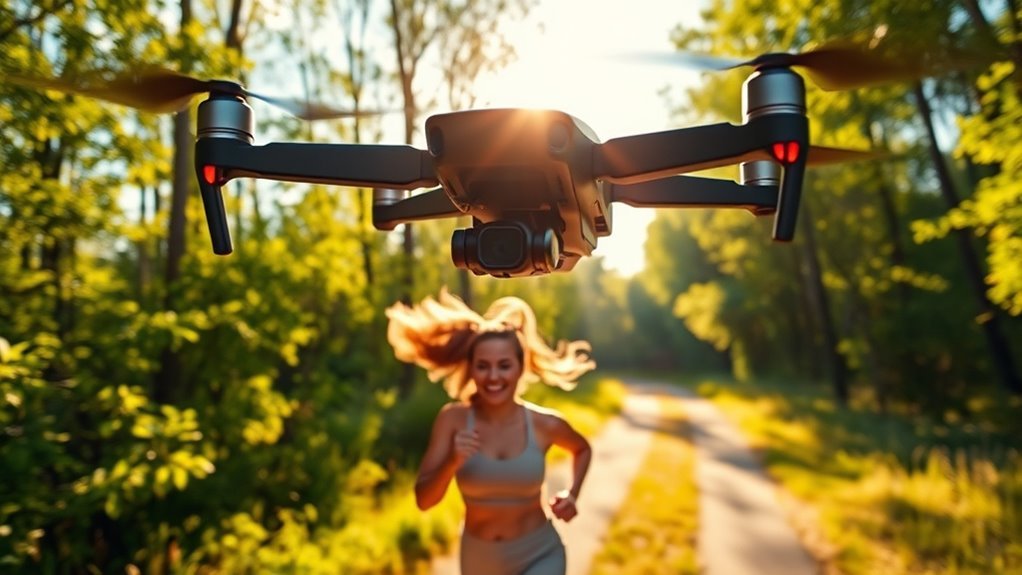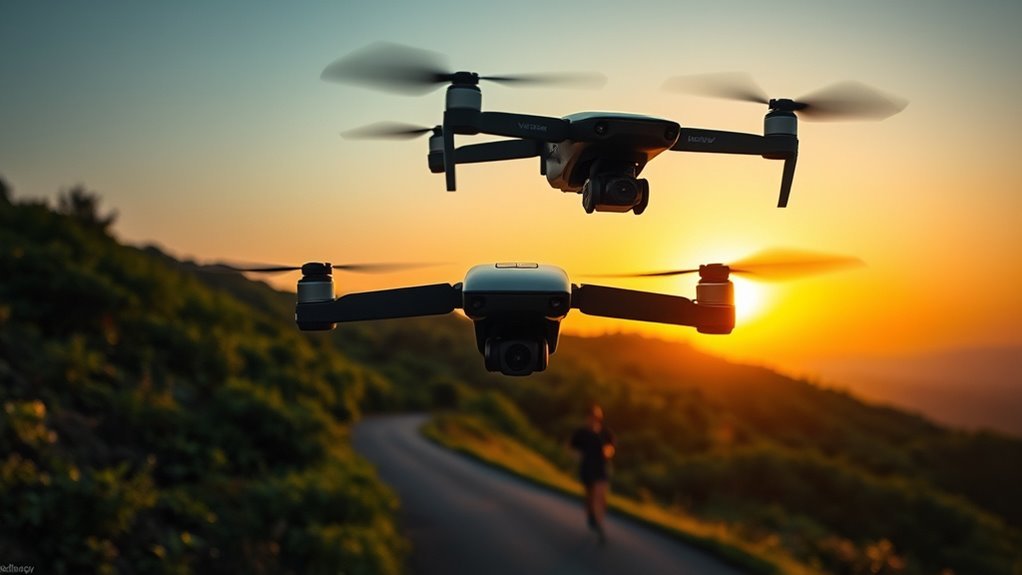Drones can follow you by leveraging a combination of GPS navigation, onboard sensors, and AI technology. With GPS, the drone tracks your movements accurately, while sensors like LiDAR and cameras help it navigate and avoid obstacles. Different tracking modes, such as GPS Follow and Visual Tracking, enhance adaptability. Understanding the factors affecting tracking accuracy, such as environmental conditions, is essential for peak performance. Continue to explore the innovations shaping the future of drone tracking.
Understanding Drone Tracking Technology
While drone tracking technology has evolved considerably, understanding its core components is vital for grasping how these devices follow you. At the heart of this technology are drone communication systems, which enable real-time data exchange between the drone and its operator. These systems utilize various protocols to guarantee seamless connectivity, allowing for precise tracking. Additionally, user interface design plays an important role in optimizing the interaction between you and the drone. A well-designed interface guarantees that you can easily control the drone’s movements and monitor its position, enhancing your freedom to navigate. By comprehending these elements, you empower yourself to make informed choices about how drones operate and how they can be leveraged to support your needs and aspirations. Moreover, understanding the limitations of signal penetration challenges is crucial for optimizing the drone’s tracking capabilities in various environments. Furthermore, effective compliance strategies, such as regular audits and certifications, can enhance the operational resilience of drones in tracking applications.
The Role of GPS in Drone Navigation

Drone tracking relies heavily on GPS technology, which plays a vital role in enabling precise navigation. Understanding how GPS integrates into drone navigation systems can enhance your freedom in utilizing these devices for location tracking. Key aspects include:
- GPS Signal: This provides essential data for real-time updates on drone positioning. Additionally, maintaining a strong signal strength is crucial for effective communication and navigation.
- Accuracy Issues: Factors like geographical limitations and signal interference can affect navigation precision.
- Satellite Technology: Drones rely on multiple satellites to triangulate their positions, ensuring effective navigation in diverse environments.
Despite potential challenges, GPS remains fundamental for reliable navigation. By grasping these elements, you can better appreciate how drones follow you and the importance of overcoming any limitations for optimal performance. Additionally, advancements in drone technology, such as DJI’s superior design, optimize power usage, which can further enhance navigation capabilities.
Onboard Sensors: Keeping Drones Aware

As drones navigate complex environments, onboard sensors play an essential role in maintaining awareness of their surroundings. These sensors collect data that informs onboard processing, ensuring drones adapt to dynamic conditions. Additionally, drones like the Lucid Sanitization Drone utilize AI-driven navigation to enhance their operational effectiveness in real-time. Real-time data processing allows these drones to analyze their surroundings instantly, further improving their responsiveness to environmental changes.
| Sensor Type | Purpose | Example Usage |
|---|---|---|
| LiDAR | Distance measurement | Terrain mapping |
| Cameras | Visual recognition | Object tracking |
| Ultrasonic sensors | Proximity detection | Obstacle avoidance |
| IMU (Inertial Measurement Unit) | Orientation detection | Stabilization |
| GPS | Location tracking | Navigation assistance |
Artificial Intelligence and Machine Learning
Artificial intelligence and machine learning are essential for enabling drones to recognize objects and track paths effectively. You’ll find that object recognition technology allows drones to identify and differentiate between various targets in real-time. Meanwhile, path tracking algorithms guarantee that these drones can follow you accurately, adapting to changes in your movement seamlessly.
Object Recognition Technology
While maneuvering complex environments, drones leverage advanced object recognition technology powered by artificial intelligence (AI) and machine learning (ML) to enhance their operational efficiency. This technology offers significant benefits, including:
- Object Detection Advancements: It enables drones to identify and categorize various objects with high accuracy, improving decision-making.
- Real-Time Processing: Drones can analyze data instantaneously, allowing them to adapt to dynamic environments and respond effectively to obstacles.
- Enhanced Tracking: AI algorithms facilitate continuous monitoring of moving targets, ensuring drones can follow you seamlessly.
Path Tracking Algorithms
To effectively follow a moving target, drones utilize path tracking algorithms that integrate advanced artificial intelligence (AI) and machine learning (ML) techniques. These algorithms leverage path optimization techniques to continuously refine the drone’s flight trajectory, ensuring it remains close to the target despite any changes in speed or direction. By employing trajectory prediction methods, drones anticipate the target’s movements, allowing for preemptive adjustments in their flight path. This synergy of AI and ML not only enhances the drone’s responsiveness but also improves energy efficiency, essential for extended operations. As you explore the potential of these technologies, you’ll appreciate how they empower drones to provide a seamless following experience, revealing new possibilities for personal freedom and creative applications.
Different Tracking Modes in Drones
As drones become increasingly sophisticated, understanding their various tracking modes is essential for maximizing their utility in diverse applications. Here are three common follow me modes that showcase drone capabilities:
- GPS Follow Mode: This mode utilizes GPS signals to keep the drone aligned with your movements, ideal for outdoor activities. Drones equipped with advanced camera capabilities can capture stunning visuals while following you seamlessly.
- Visual Tracking Mode: Leveraging computer vision, the drone identifies and follows you based on visual cues, providing a more dynamic tracking experience.
- Beacon Follow Mode: Using a designated tracking device, the drone maintains a consistent distance, ensuring you’re always in its field of view. Additionally, advancements in AI-enhanced obstacle avoidance allow drones to navigate safely while following you, enhancing overall flight safety.
Applications of Follow-Me Drones
Given the advancements in drone technology, follow-me drones have found a wide array of applications across various fields. One of the most exciting areas is adventure filming, where you can capture breathtaking landscapes and dynamic action shots without needing a dedicated camera operator. Whether you’re hiking, biking, or skiing, a follow-me drone guarantees you’re always in frame, allowing for creative storytelling. In sports photography, these drones excel by tracking athletes during competitions, providing unique perspectives that traditional photography can’t achieve. This capability not only enhances the visual appeal of sporting events but also allows for real-time footage, perfect for social media sharing. Ultimately, these applications empower you to document your adventures and athletic pursuits with unparalleled freedom and ease. Additionally, the advanced multi-directional sensors in drones like the DJI Air 3S enable them to avoid obstacles while following you, ensuring safe and reliable operation during your activities. Furthermore, the incorporation of AI-driven choreography in drone technology allows for even greater adaptability and precision in capturing dynamic movements.
Factors Affecting Tracking Accuracy
While follow-me drones offer impressive tracking capabilities, several factors can greatly influence their accuracy. Understanding these elements can enhance your user experience and guarantee seamless operation. Here are three key factors to take into account:
- Environmental Conditions: Weather, including wind speed and precipitation, can disrupt signal integrity and affect tracking reliability. Additionally, cold temperatures can impact battery performance, potentially leading to reduced flight times and power output, which may affect tracking accuracy.
- Obstacle Proximity: The presence of large structures or dense foliage may obstruct the drone’s line of sight, leading to inaccuracies.
- GPS Signal Quality: A strong and clear GPS signal is essential for precise tracking; interference from buildings or electronic devices can compromise this. Additionally, signal strength and communication limits play a crucial role in maintaining a reliable connection between the drone and its controller, which is vital for effective tracking.
Safety Considerations for Drone Tracking
When utilizing drones for tracking, you must consider privacy concerns, as individuals may not want their movements monitored. Compliance with regulatory requirements is essential to guarantee lawful operation. Additionally, implementing collision avoidance technologies is critical to prevent accidents and enhance safety during tracking activities. Understanding local regulations is vital to ensure that your drone operations remain within legal boundaries. Furthermore, adhering to FAA regulations helps ensure that drone operations are conducted safely and responsibly.
Privacy Concerns for Individuals
As drones become increasingly capable of tracking individuals, concerns about privacy are more pressing than ever. You might want to reflect on these key issues:
- Data Privacy: Drones can collect vast amounts of personal data, raising questions about who owns and controls that information.
- Surveillance Ethics: Ethical implications arise when drones monitor individuals without consent, challenging the balance between security and personal freedoms.
- Potential Misuse: There’s a risk that tracking data could be exploited by unauthorized entities, leading to harassment or discrimination.
As drone technology evolves, it’s essential to scrutinize these privacy concerns to safeguard your rights. Understanding the implications of surveillance and advocating for ethical standards can empower you to enjoy the benefits of technology while protecting your freedoms.
Regulatory Compliance Requirements
To guarantee safety and compliance in drone tracking, operators must adhere to a complex framework of regulations that govern aerial surveillance. Understanding these regulatory frameworks is essential for anyone looking to utilize drones effectively. Each region has specific compliance standards that dictate operational limits, privacy protections, and safety protocols. For instance, you’ll need to be aware of airspace restrictions, required permits, and the necessity for real-time communication with air traffic control in certain areas. Failure to comply with these standards could not only result in legal repercussions but also jeopardize public safety. Engaging with local authorities and staying updated on regulatory changes is vital to ascertain your drone operations align with current laws, preserving both your freedom and the safety of those around you.
Collision Avoidance Technologies
Although drone technology has advanced considerably, guaranteeing safety during operation remains a top priority, particularly in collision avoidance. To enhance safety, you’ll find several critical technologies in play:
- Collision Detection Systems: These employ sensors to identify nearby objects, alerting the drone to potential hazards.
- Obstacle Avoidance Algorithms: By processing real-time data, these algorithms enable drones to navigate around obstacles autonomously.
- Redundant Safety Mechanisms: Integrating multiple sensors guarantees that if one system fails, others can maintain safe operations.
These technologies work in tandem, fostering an environment where you can enjoy the freedom of drone tracking without fear of collisions. As advancements continue, safety features will evolve, enhancing your overall experience with these innovative devices.
Choosing the Right Drone for Your Needs
When you’re selecting a drone, understanding your specific needs is critical to making the right choice. Consider the drone features that align with your intended use—such as camera quality, battery life, and GPS capabilities. If you’re planning to capture high-quality aerial footage, look for drones equipped with advanced stabilization and high-resolution cameras. Additionally, check user reviews to gain insights into real-world performance and reliability. The Dji Mini 4 offers a strong balance between advanced features and affordability, making it an excellent option for various users. Pay attention to factors like ease of use and customer support, as these can greatly impact your experience. Ultimately, the right drone should not only fulfill your requirements but also provide you the freedom to explore and create. Select a model with advanced features and intelligent modes to enhance your aerial photography capabilities. Choose wisely, and you’ll enhance your aerial adventures.
Future Trends in Drone Tracking Technology
As drone technology evolves, the tracking capabilities are becoming increasingly sophisticated. You can expect several future applications driven by technological advancements:
- Enhanced GPS Integration: Drones will utilize advanced satellite systems for real-time positioning, improving accuracy and reliability.
- AI-Powered Object Recognition: Machine learning algorithms will enable drones to identify and follow individuals or objects seamlessly, adapting to dynamic environments.
- Swarm Technology: Multiple drones will coordinate their movements, sharing data to enhance tracking capabilities and coverage.
These innovations will not only increase efficiency but also expand the potential for personal and commercial use. As you explore these advancements, consider how they can provide both convenience and freedom in various applications, from recreational pursuits to essential surveillance.
Frequently Asked Questions
Can Drones Follow Multiple People at Once?
Imagine a flock of birds, each guided by instinct. With advanced drone technology and sophisticated tracking algorithms, drones can indeed follow multiple people simultaneously, seamlessly adapting their paths while respecting your need for freedom and personal space.
How Far Can Drones Track a Person?
Drones can track a person up to several miles, depending on GPS technology and tracking accuracy. Factors like terrain and obstacles can affect their range, but advancements continually enhance their capabilities for effective monitoring.
Do I Need an App for Drone Tracking?
You might think drone tracking’s complicated, but it doesn’t have to be. Mobile applications simplify the process, offering user-friendly interfaces. With the right app, you can effortlessly monitor and control your drone’s movements.
What Happens if the Drone Loses Connection?
If the drone loses connection, it typically relies on its GPS signal for location. You may experience a temporary interruption, but most drones are designed for connection recovery, automatically returning to a preset home point for safety.
Can Drones Follow Me Indoors?
Drones can follow you indoors, but it requires advanced indoor navigation systems and precise drone sensors. These technologies help them navigate obstacles, ensuring they maintain proximity while allowing you freedom of movement within enclosed spaces.

